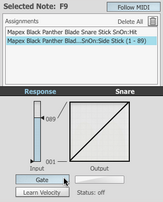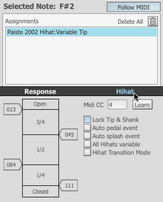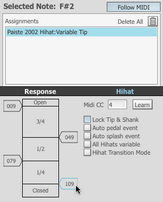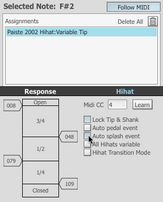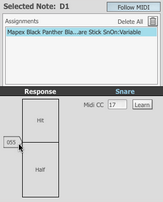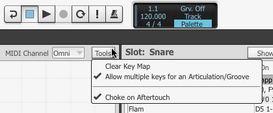BFD3 supports the use of electronic drumkits for triggering sounds, with pre-made maps provided for most kits. The Key Map panel provides a number of tools to customize mappings or response characteristics.
Most triggers/pads on electronic kits are fairly straightforward to map to BFD3's Drum articulations. Certain types of triggers which use more advanced control techniques may require some customization for your playing style, such as hihat and positional snare triggers when using kits capable of sending out MIDI CCs in order to control articulation switching. BFD3 provides 'variable' hihat and snare articulations to use with these types of controllers.
This section assumes that you are familiar with using the Key Map panel, explained in the previous section.
How electronic drumkits work
Electronic drumkits, or 'e-drums' usually consist of a number of pads which transmit trigger signals as control voltage over an audio connection. Additionally, a pedal mechanism that transmits the variable state of the pedal between open and closed, again using a control voltage over an audio connection.
The audio signals are routed to a converter box, commonly referred to as a 'drum brain', which translates audio signals received from pads into MIDI messages. The brain often also has onboard sounds, which tend to be rather limited due to memory constraints.
Common e-drum systems include D-Drums (formerly made by Clavia), Roland V-Drums, the Yamaha DT series and Alternate Mode Drumkat. Note that some budget e-drum systems such as the Ion kit do not support variable hihat pedals, instead using a switch pedal that simply changes between open and closed states. You cannot utilize variable hihat control with such kits.
Cross-talk between triggers and zones
It s very common to experience cross-talk symptoms when using e-drum systems – when a pad is struck, the resulting vibrations are picked up by other pads' trigger sensors.
This crosstalk problem is often compounded by the fact that most e-drum systems are supplied with a single-frame mounting system, resulting in little isolation for each pad. In addition to cross-talk between individual pads, substantial cross-talk also occurs between zones on multi-zone pads.
In practice, this is often not a major problem, as it reflects what would happen with real drumkit to some extent. However, when using BFD3, it can cause the following issues:
• Excess disk streaming due to more voices being triggered at once
• Problems when using MIDI learn for note assignments due to multiple notes being transmitted when striking a pad or zone on a pad.
|
It can be more effective to manually assign notes in the Key Map page rather than using Learn-based functions. In order to do this, you will need documentation regarding the notes transmitted by each pad on your electronic kit. Alternatively, the brain itself may provide setup pages which provide this information. There may be situations, however, when you may have to examine the MIDI output from your drum brain: BFD3's MIDI Event Log allows you to do this. The Input Range and Gate functions in BFD3's Mapping Response panel can be used to overcome the problems associated with crosstalk - see the previous section for details on using these functions. |
Double-triggering: setting the Retrigger threshold
Another similar problem is 'double-triggering' and unwanted choking of sounds, especially when using dual-zone triggers. Most drum brains feature configuration parameters for overcoming cross-talk and double-triggering problems.
The Retrigger threshold setting in the Engine Preferences adjusts for double-triggers in real time - it defines a length of time after each received note during which all further notes are ignored.
Note that it is usually preferable to eradicate these problems at the source. Please consult your e-drum system documentation for information on how to minimize the effects of cross-talk and double-triggering with your kit.
Latency
An inherent problem with computer-based digital audio systems is the concept of latency, meaning that BFD3 may not respond as quickly as any onboard sounds in the drum brain.
It is important to remember that latency is NOT caused by BFD3. Any sources of latency issues lie elsewhere in your system:
• Possible additional processing time required in the brain to create the MIDI output, as opposed to triggering the internal sounds.
• Any inherent latency and timing inaccuracies involved with connecting the brain's MIDI output to the computer’s MIDI interface.
• Any latency involved in getting the data from the MIDI interface to BFD3. This varies with the quality of the hardware and drivers of the MIDI interface.
• Audio interface latency/buffer size - smaller buffer sizes result in lower latencies. However, they also require more CPU power and well-engineered audio interface hardware and drivers.
Bus traffic problems
You may find it particularly difficult to achieve low latencies on laptops and smaller machines with limited expansion potential – no ability to install dedicated internal drives or audio interfaces. This means you may need to chain devices on the same firewire or USB bus for example. This often leads to dropouts at lower latencies.
It is highly recommended to run the hard drive containing BFD3's sounds from a separate bus to the audio interface.
Recommended systems for low latency
•A high quality audio interface capable of reliably operation at 64 or 32 sample latency (1.5ms or 0.75ms at 44.1 kHz) - a PCI, PCI-Express, Thunderbolt, CardBus or ExpressCard interface tends to achieve the best results
•A reliable PCI, USB2 or USB3 MIDI interface
•An internal SATA-connected 7200 RPM drive or SSD for the sounds is preferable – if this is not possible, use an external USB2 or USB3 drive on its own bus
•A fast CPU, well set-up drivers and 8GB or more of RAM
If it is not possible to assemble a system capable of stable low latency operation, it may be best to record your performance while monitoring the sounds in your drum brain, and subsequently route the recorded MIDI to BFD3's sounds.
Simple hihat control
The easiest way to control hihats in BFD3 with an electronic kit is by ignoring the MIDI CC transmitted by the brain according to the hihat pedal position and instead simply using the open, closed and pedal hihat notes transmitted by the brain.
The drum brain calculates whether to send out an open or closed hihat note depending on the state of the hihat pedal. Some brains that support multi-zone triggers are capable of sending out different open and closed notes for tip (also known as bow) and shank (edge) triggers. A pedal note is usually transmitted when the hihat pedal controller is fully depressed.
Example: Roland TD-20
The following table shows how to map the notes transmitted by a Roland TD-20 to achieve non-variable hihat control.
Roland note Closed Bow Closed Edge |
MIDI note* (note no.) F#1 (42) A#-1 (22) |
BFD3 mapping closed tip closed shank |
* MIDI note octaves are specified using -2 octave numbering (lowest note is C-2)
It is highly recommended to remap A#1 and D0 to 1/2-open tip and 1/2-open shank, as these represent the most common type of open hat sound. The Open tip articulation in particular is more like a hihat bell sound, or a small ride cymbal.
Advantages and disadvantages of non-variable hihat control
While it may be argued that using this method is less expressive than using the variable hihat control method described below, the resulting MIDI data is much easier to edit in a MIDI sequencer or DAW.
When using a MIDI CC for the hihat pedal position, reecorded CC values must be moved along with any notes when editing, which may be cumbersome.
With the simple hihat control method, any editing and quantizing required is much more straightforward as only notes are involved. The open notes can be moved to other hihat articulations after recording in order to make parts more expressive.
BFD3's internal Groove recording function automatically converts any variable note/CC input that is received to discrete articulations.
Variable hihat control
Overview
Electronic drumkits often use a hihat pedal controller which sends out MIDI continuous controller messages to represent its position within open and closed states. BFD3 is capable of analyzing this controller data while a hihat trigger is received to determine which hihat articulation to play from those available: closed, 1/4-open, 1/2-open, 3/4-open or fully open. For this to occur, hihat MIDI notes must be mapped to special 'Variable' hihat articulations.
Important note
BFD3 allows variable hihat control only for the Hihat slot. You may load additional hihats in other slots and trigger their articulations directly with MIDI notes, but variable hihat control is restricted to the Hihat slot only.
Assigning variable tip and variable shank articulations
|
Any hihat note transmitted by your electronic drumkit brain should be assigned to either a Variable tip or Variable shank articulation, with one important exception. Almost all brains send out a 'pedal', or 'foot-chick', sound when the hihat control pedal is depressed fully: this note should always be mapped to BFD3's Pedal articulation. The Variable tip is used for the main surface or 'bow' of the hihat, which should be used if you only have a single-zone hihat trigger pad. 'Tip' refers to the fact that the surface of the hihat is struck with the tip of the stick. The Variable shank is used for the edge of the hihat - this should be used in addition to the variable tip if your hihat pad has a dual-zone trigger. 'Shank' refers to the fact that the edge of the hat is struck with the shank, or body, of the stick. |
Example: Roland TD-20
A good example is the Roland V-Drums range of kits. Most Roland drum brain models send out the same set of notes for the hihat. The following table illustrates which notes to map to which articulation.
Roland note Closed Bow Closed Edge |
MIDI note (note no.) F#1 (42) A#-1 (22) |
BFD3 mapping Variable tip Variable shank |
* MIDI note octaves are specified using -2 octave numbering (lowest note is C-2)
** The hihat pedal controller signal is transmitted via MIDI CC #4.
The Roland brain decides whether to send the 'open' or 'closed' note depending on the pedal controller value and a setting on the brain dictating the transition point between open and closed.
This distinction is unimportant to BFD3 because it contains additional 1/4-open, 1/2-open and 3/4-open sounds. Therefore the open and closed sounds should mapped to the same Variable articulation. BFD3 makes its own decisions about which actual hihat articulation to play, depending on the value of the pedal controller and the settings in the Hihat response panel in the Key Map page.
The pedal note, meanwhile, chokes any playing open sound and plays the hihat pedal articulation (the 'foot-chick' sound).
Assigning the hihat pedal MIDI CC and adjusting its response
|
Hihat pedals in most electronic kits transmit a MIDI continuous controller (CC) in order to represent the position of the pedal between open and closed. A value of 0 means that the pedal is open (fully up). As the pedal is moved down, the value of the MIDI CC increases. The maximum possible value is 127. Usually, MIDI CC #4 is used for this purpose, and this is the default setting for the Hihat MIDI CC in BFD3. The Hihat Response panel can be used to change this to a different MIDI CC#, and to customize the response of BFD3 to received pedal controller values. Hihat Response panel In order to view the Hihat Response panel, a key containing a Variable tip or Variable shank hihat articulation must first be selected using the keyboard displays in the Key Map panel. |
The controls in this panel allow you to define a number of settings for variable hihat control:
MIDI CC
This setting specifies the MIDI CC# to use for the hihat pedal. The setting used here depends on the value transmitted by your drum brain. To set the value, you can either:
•Click the value, type a new number between 1 and 127 and hit ENTER.
•Click the Learn button to the right of the setting and move your hihat pedal to detect the pedal CC. You may need to strike your hihat pad shortly before moving the pedal for the value to be transmitted.
|
Pedal transitions The Pedal transitions control specifies the articulation transition points over the range of hihat height MIDI CC values. This control features 4 adjustable points on a vertical slider, with each point representing the transitions between the hihat articulations over the pedal range. These transition points form 5 'zones' for closed, 1/4-open, 1/2-open, 3/4-open and fully open articulations. Each of the transition points displays a value from 0 to 127, which corresponds to the hihat pedal MIDI CC value at which the transition occurs. Click and drag the transition points up and down to adjust them. When a Variable tip is triggered, the concurrent value of the hihat pedal MIDI CC is analyzed. The appropriate articulation is played depending in which 'zone' of values the MIDI CC falls. |
For example, let's say that the points for the Variable tip articulation are set to values of 10, 50, 80, and 110. This means that the 'zones' of MIDI CC values translate to hihat articulations as follows:
0-9 10-49 50-79 80-109 110-127 |
open 3/4-open 1/2-open 1/4-open closed |
* MIDI note octaves are specified using -2 octave numbering (lowest note is C-2)
** The hihat pedal controller signal is transmitted via MIDI CC #4.
Therefore, if the CC value is 30 and the Variable tip articulation is triggered, a 3/4-open tip articulation is played. If it is 110, a closed tip is played, and so on.
Variable tip and Variable shank articulations have distinct Pedal transitions settings, although by default they are linked with the Lock Tip & Shank setting.
When using a hihat with less than the maximum number of articulations, BFD3 intelligently remaps triggers to closest appropriate articulation that does exist. This occurs if any articulations are unloaded in the Kit display, or when using hihats from other BFD3-compatible libraries which do not feature a full set of articulations.
The Pedal transitions settings can be used to overcome the common problem of hihat controller pedals not sending out the maximum possible range of MIDI CC values. For example, its maximum value (when fully closed) may be 90 instead of 127. If this is the case, adjust the transition point between closed and 1/4-open so that its value is 90 or less - 80 would be a good starting point to try - and move the other sliders to appropriate points over the rest of the available range.
The MIDI Event Log can be very useful in examining the data transmitted by your controller pedal and drum brain.
|
Lock Tip and Shank If you don't need to separately adjust the Variable tip and Variable shank Pedal transitions response, you can activate the Lock Tip and Shank button. This locks the settings of both Variable articulations together, so that the Pedal transitions slider values are exactly the same for both articulations. This setting is activated in the default BFD3 Key Map. Auto pedal event This setting is to be used when using variable hihat control with electronic drum brains which do not send out a pedal (foot-chick) note automatically when the hihat pedal is full depressed. When the setting is activated, a pedal note is generated whenever the hihat pedal MIDI CC reaches the first value within the 'closed zone' defined with the Pedal transitions control in the Hihat Response panel. |
If your drum brain sends out a pedal note when the hihat pedal is fully depressed (Clavia D-Drum and Roland V-Drum brains fall into this category), then you should deactivate this setting if it is enabled.
Auto splash event
When using an electronic drumkit with variable hihat controller pedal, activating this setting results in an open hihat sound being generated if the hihat pedal is opened soon after a closed tip, closed shank or Pedal articulation. The length of time within which this function operates is defined by the Hihat Reopen Threshold setting in the Preferences.
It is highly recommended to enable this setting when using some Roland drum brains such as the TD-20.
All Hihats variable
This setting represents a quick way of changing a set of regular hihat articulations into a variable hihat setup. It works by changing all hihat articulation mappings (with the exception of the pedal articulation) to variable equivalents.
To illustrate this using the Roland TD-20 example:
Roland note Closed Bow Closed Edge |
MIDI note* (note no.) F#1 (42) A#-1 (22) |
BFD3 mapping closed tip closed shank |
All Hihats variable enabled Variable tip Variable shank |
* MIDI note octaves are specified using -2 octave numbering (lowest note is C-2)
** The hihat pedal controller signal is transmitted via MIDI CC #4.
In the table above, the column to the extreme right shows the effective mappings with the setting enabled. The original mappings are not changed - you can return to normal by disabling the preference.
While the preference is enabled, hihat articulations display the relevant variable hihat controls in the Advanced mapping settings display instead of the standard settings, so you can customize hihat response as you would when dealing with variable tip and variable shank articulations.
Hihat Transition Mode
Activating this setting enables smooth transition modelling between hihat positions.
Preference settings related to hihat control
Retrigger threshold (Engine Preferences/Synth Engine section)
As mentioned earlier, the Retrig Threshold setting in the Engine Preferences exists to combat double-triggering problems. Dual-zone hihats can be especially prone to this. Increasing this setting may help in overcoming such problems.
Hihat choke fade settings (Engine Preferences/Fades section)
The hihat has more choke fade settings than other Drum types because of its more complex nature. The default Hihat choke fade settings should be adequate for most purposes, using both e-drums and more conventional input means.
The default values are as follows:
Hihat choke fade (base) Hihat choke fade (range) Hihat closed tip choke fade Hihat pedal choke fade |
0.500 0.500 0.050 0.050 |
These settings result in a fast choke on a hihat articulation that is currently playing if a pedal note (usually G#1) is received (it also performs a fast choke on closed tip articulations – see later). Most drum brains send out a pedal note when the hihat pedal is fully depressed, in addition to the MIDI controller messages for pedal movement.
All other articulations are choked more slowly, allowing more natural cymbal-style choking for open hihat sounds. This also means that that open hats will not be choked when drum brains send out spurious MIDI notes due to cross-talk between zones etc.
Additionally, there is a separate choke fade setting for Closed Tip sounds. This is provided for keyboard drummers and programmers who are accustomed to choking open hats with a closed hat due to unfamiliarity with physical hihat behaviour.
You may find that your e-drum system is demonstrating a lot of cross-talk between hihat zones and perhaps sending out undesired Closed Tip notes. If this is the case, try increasing the Hihat closed tip choke fade setting to a larger value.
Please note that since the Closed Shank articulation is quite a splashy sound, not unlike a 1/4-open tip, it is treated as an 'open' articulation - it chokes open articulations with the standard Hihat choke fade times.
Hihat reopen threshold (Session Preferences/Hihat setup section)
This setting defines the length of time after a Closed or Pedal hihat articulation within which the Auto Pedal Splash function, set in the Hihat Response panel, is active.
This setting is defined in musical notes, as the time required for this function typically varies according to the tempo. It is set at 1/64-note by default, which is optimal for most situations. However, if you need to adjust this response, it can be set to between 1/128-note and 1/16-note.
Hihat transition fade time (Session Preferences/Hihat setup section)
This setting adjusts the amount of time for the transmuting processes associated with the Hihat Transition Mode and the Auto Pedal Splash settings.
Positional snare control
BFD3's snares, and those of many other compatible expansion packs, feature a Half Edge snare articulation, with the head of the snare struck halfway between the centre and the edge. The regular Hit articulation, on the other hand, is a result of the snare head being struck in the centre.
The Variable snare articulation allows you to access the Hit and Half Edge articulations using the positional sensing of snares in electronic drumkits such as those by Roland.
Positional sensing works by the drum brain sending out a MIDI CC representing the distance from the centre (where the value is 0) and the edge (value 127).
Using positional snares in BFD3
In order to utilize this functionality, a variable snare articulation must be mapped in the Key Map page. Typically, you should assign it to the key normally assigned to the Hit articulation, usually D2. Please ensure that it is the only articulation on the key – delete any articulations that may have originally existed.
Snare Response panel
After a Variable snare articulation has been mapped, select the key on which the mapping exists using the keyboards in the Key Map panel and then click the Snare button in the Mapping Editor to show the Snare Response panel.
|
MIDI CC This setting specifies the MIDI CC# to use for the snare position. The setting used here depends on the value transmitted by your drum brain. On Roland kits, this MIDI CC is usually CC #17. To set the value, you can either: •Click the value, type a new number between 1 and 127 and hit ENTER. •Click the Learn button to the right of the setting and strike your snare - if it transmits a CC for the position information, it is detected. Snare transition The Snare transition control is very similar in concept to the Pedal transitions control in the Hihat Response panel. It specifies the articulation transition point between Hit and Half Edge articulations over the range of the snare position MIDI CC. |
This control features an adjustable point on a vertical slider, with the point representing the transition between the 2 articulation 'zones'. The transition point displays a value from 0 to 127, which corresponds to the snare position MIDI CC value at which the transition occurs. Click and drag the point up and down to adjust it.
If the point is set at 55, this means that the two resulting zones are set as follows:
Hit Half-edge |
0-54 55-127 |
Controlling cymbals
|
Many electronic drumkits feature manual choking of cymbals by 'grabbing' the cymbal trigger pad. Such cymbal pads usually involve a pressure controller that transmits polyphonic aftertouch (poly pressure) messages associated with the cymbal MIDI notes. This feature can be used in BFD3 by enabling the Choke with aftertouch setting in the Key Map panel's Tools menu. Please note that aftertouch choking only works on Cymbal slots. |
